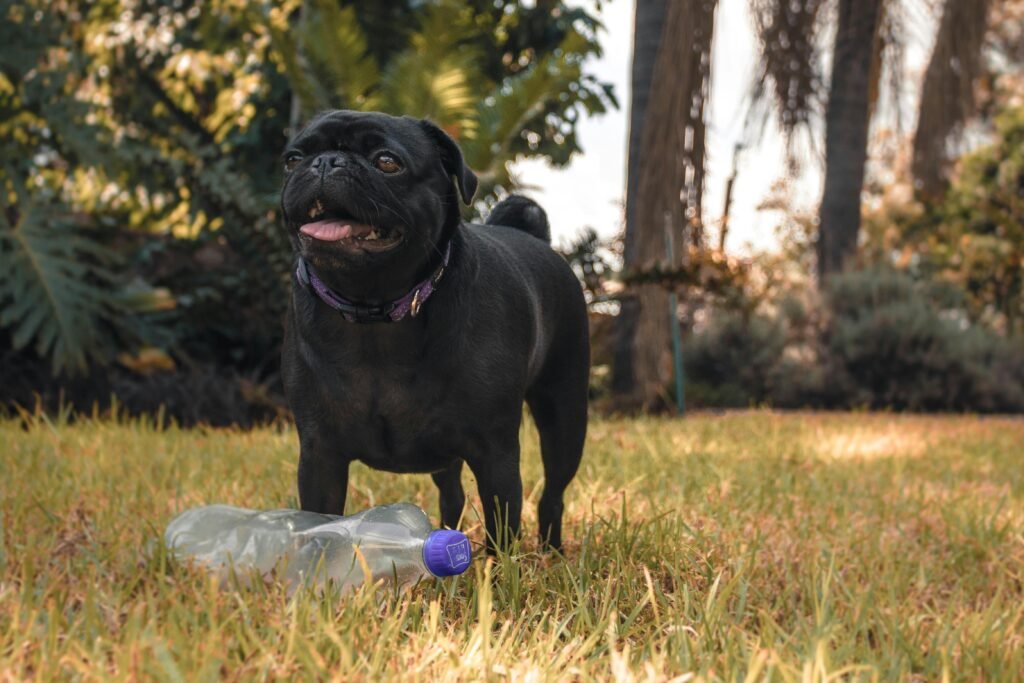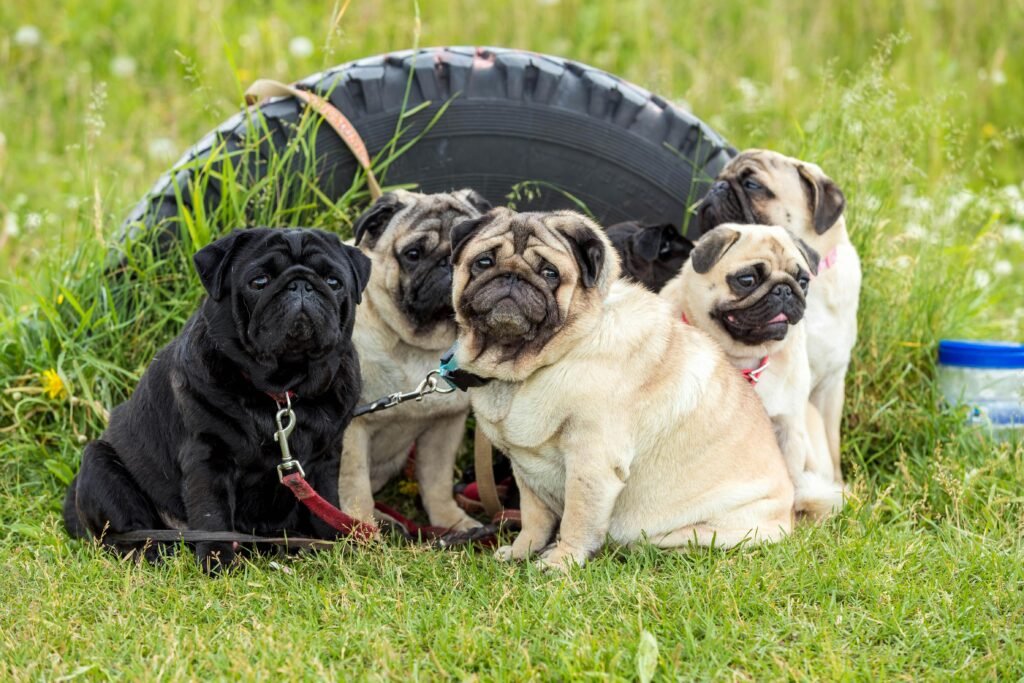Pugs are known for their charming personalities and adorable appearance, but like all breeds, they are prone to certain health concerns. In this article, we will explore some of the most common health issues that pugs may face, including respiratory problems, eye conditions, and skin allergies. By understanding these potential concerns, you can ensure that your pug receives the proper care and attention to live a happy and healthy life.

This image is property of images.pexels.com.
Brachycephalic Syndrome
Definition and Causes
Brachycephalic syndrome is a condition characterized by a combination of respiratory issues that commonly affect brachycephalic dog breeds like Pugs. These breeds have a flat, wide skull and short noses, making it difficult for them to breathe properly. The primary causes of brachycephalic syndrome are the structural abnormalities in their airways, which include elongated soft palate, narrow nostrils (stenotic nares), and a collapsing trachea.
Symptoms and Signs
It is important to recognize the symptoms and signs of brachycephalic syndrome in order to seek timely veterinary care. Pugs with this condition may show difficulty in breathing, especially during hot weather or exercise. They may also exhibit loud snoring, excessive panting, gagging, and even fainting episodes. If you notice these signs in your Pug, it is crucial to consult your veterinarian for a proper diagnosis and treatment plan.
Prevention and Treatment
While brachycephalic syndrome cannot be completely prevented in Pugs, certain measures can help minimize its impact on their health. Avoiding strenuous exercise, especially in hot weather, can help reduce the risk of respiratory distress. Providing a cool and well-ventilated environment for your Pug is also important.
In severe cases, surgical intervention may be required to correct structural abnormalities in their airways. Soft palate resection, nostril widening, and tracheal stenting are some of the surgical procedures that can improve airflow and alleviate the symptoms of brachycephalic syndrome. However, it is essential to consult with a qualified veterinarian to determine the most appropriate treatment options for your furry friend.
Eye Problems
Corneal Ulcers
Corneal ulcers are a common eye problem in Pugs. These ulcers are open sores on the cornea, which is the transparent outer layer of the eye. They can be caused by various factors, including trauma, foreign objects, or underlying eye conditions. Symptoms of corneal ulcers may include redness, excessive tearing, squinting, and sensitivity to light. If you notice any signs of corneal ulcers in your Pug, it is crucial to seek veterinary care immediately, as untreated ulcers can lead to more serious complications.
Dry Eye
Dry eye, also known as keratoconjunctivitis sicca, is another eye problem commonly seen in Pugs. It occurs when the eyes do not produce enough tears to keep the cornea lubricated. This can result in symptoms such as redness, discharge, frequent blinking, and discomfort. Treatment for dry eye in Pugs often involves the use of artificial tear solutions or ointments to provide lubrication and stimulate tear production. In severe cases, medication or surgery may be necessary to manage the condition effectively.
Progressive Retinal Atrophy (PRA)
Progressive retinal atrophy is a degenerative eye disorder that eventually leads to blindness in affected dogs. Pugs are prone to developing PRA, which involves the gradual deterioration of the retina, the light-sensitive tissue at the back of the eye. Symptoms of PRA may include night blindness, dilated pupils, and a decline in overall vision. Unfortunately, there is currently no cure for PRA, but supportive management, such as providing a safe and familiar environment, can help affected Pugs adapt to their vision loss.
Cherry Eye
Cherry eye is a condition characterized by the prolapse of the tear gland located in the corner of the eye. This results in a pink, fleshy mass protruding from the eye, resembling a cherry. Pugs are more susceptible to developing cherry eye due to their facial structure and genetic predisposition. Although cherry eye itself is not painful, it can lead to complications like dry eye if left untreated.
Treatment for cherry eye typically involves surgical repositioning of the tear gland to its normal position. It is important to address cherry eye promptly to prevent further complications and maintain your Pug’s eye health.

This image is property of images.pexels.com.
Wrinkle Care
Skin Fold Dermatitis
The adorable wrinkles that Pugs are known for can unfortunately become a breeding ground for skin fold dermatitis. This condition occurs when the skin folds become moist and prone to bacterial or fungal infections. Symptoms of skin fold dermatitis may include redness, itching, and a foul odor. To prevent this condition, it is crucial to keep your Pug’s wrinkles clean and dry. Regularly clean the folds with a gentle, pet-safe wipe, and ensure that they are completely dry afterward.
Cleaning and Maintenance
In addition to preventing skin fold dermatitis, regular cleaning and maintenance of your Pug’s wrinkles are essential for their overall hygiene and well-being. Gently wipe the wrinkles with a damp cloth or a pet-safe wipe to remove any debris, dirt, or excess moisture. Be sure to dry the wrinkles thoroughly, as moisture trapped in the folds can lead to skin infections. Keeping the wrinkles clean and dry will help keep your Pug comfortable and happy.
Respiratory Issues
Stenotic Nares
Stenotic nares, or narrow nostrils, are a common respiratory issue in brachycephalic dog breeds like Pugs. This condition occurs when the nostrils are too narrow to allow for proper airflow, making it difficult for them to breathe efficiently. Symptoms of stenotic nares may include loud snoring, snorting sounds, and an increased effort to breathe. If your Pug exhibits these signs, it is important to consult with your veterinarian for a proper diagnosis. Surgery can often be performed to widen the nostrils and improve breathing.
Collapsed Trachea
A collapsed trachea is another respiratory issue that can affect Pugs. In this condition, the trachea, or windpipe, loses its structural integrity and collapses, restricting the passage of air. Symptoms of a collapsed trachea may include coughing, wheezing, difficulty breathing, and exercise intolerance. While surgery may be necessary in severe cases, management of a collapsed trachea often involves weight control, avoiding irritants such as smoke, and using harnesses instead of collars for walking.
Exercise Considerations
Due to their brachycephalic nature and predisposition to respiratory issues, Pugs have specific exercise considerations. It is important to avoid excessive exercise, especially in hot or humid weather, as it can quickly lead to overheating and respiratory distress. Instead, opt for short and gentle walks in cooler temperatures to prevent putting unnecessary strain on your Pug’s respiratory system. Regular breaks for rest and water are also essential during physical activities.

This image is property of images.pexels.com.
Overheating and Heat Stroke
Factors Contributing to Overheating
Pugs are particularly prone to overheating due to their shortened muzzles and compromised ability to cool themselves down through panting. Factors that can contribute to overheating include hot weather, high humidity, lack of shade or proper ventilation, and excessive physical activity. It is important to be mindful of these factors and take appropriate measures to prevent your Pug from overheating.
Recognizing Heat Stroke
Heat stroke is a life-threatening condition that can occur as a result of overheating. It is crucial to recognize the signs of heat stroke early on to seek immediate veterinary intervention. Symptoms of heat stroke may include rapid panting, excessive drooling, lethargy, vomiting, and collapse. If you suspect your Pug is experiencing heat stroke, move them to a cool, shaded area, apply cool (not cold) water to their body, and seek veterinary care immediately.
Preventing Heat Stroke
Preventing heat stroke in Pugs involves proactive measures to keep them cool and comfortable. Provide access to fresh water at all times, particularly during hot weather. Avoid leaving your Pug in a car or an area without proper ventilation. When outdoors, seek shade and limit exposure to direct sunlight. Additionally, consider using cooling mats or vests specifically designed for pets to help regulate their body temperature. Being vigilant and attentive to your Pug’s well-being during hot weather will reduce the risk of heat stroke.
Allergies
Types of Allergies
Pugs can be susceptible to various types of allergies, including environmental allergies, food allergies, and flea allergies. Environmental allergies, also known as atopic dermatitis, are caused by sensitivities to common allergens in the environment, such as pollen, dust mites, or mold. Food allergies, on the other hand, occur when a Pug’s immune system reacts negatively to certain ingredients in their diet. Flea allergies result from hypersensitivity to flea bites.
Common Allergy Symptoms
Allergies can manifest in a variety of symptoms, but common signs to watch for in your Pug include itching, redness, skin rashes, hair loss, excessive licking or biting of the paws, and recurrent ear infections. If you suspect that your Pug has allergies, it is important to consult with your veterinarian for proper diagnosis and management.
Managing Allergies
Managing allergies in Pugs often involves a multi-faceted approach. This may include avoidance of known allergens, such as regularly cleaning their living environment, using hypoallergenic bedding, and trying different food options if a food allergy is suspected. Your veterinarian may also recommend medications or allergen-specific immunotherapy (allergy shots) to help alleviate your Pug’s symptoms. Regular grooming and keeping your Pug’s skin and coat clean can also help minimize the impact of allergies.
Joint and Bone Problems
Hip Dysplasia
Hip dysplasia is a common joint problem in Pugs and other breeds. It is a condition where there is an abnormal development of the hip joint, leading to improper alignment and potential arthritis. Symptoms of hip dysplasia may include lameness, difficulty standing up or climbing stairs, and decreased activity levels. While hip dysplasia cannot be fully prevented, weight management, regular exercise, and a balanced diet can help minimize its impact and provide some relief. In severe cases, surgical options may be considered.
Patellar Luxation
Patellar luxation is another joint problem that can affect Pugs. It occurs when the kneecap (patella) dislocates from its normal position, leading to discomfort, lameness, and an abnormal gait. Mild cases of patellar luxation can often be managed through weight control, physical therapy, and anti-inflammatory medications. In more severe cases, surgical intervention may be necessary to correct the dislocated patella and restore normal joint function.
Osteoarthritis
Osteoarthritis is a degenerative joint disease that commonly affects aging Pugs. It involves the progressive deterioration of the cartilage in the joints, leading to pain, stiffness, and reduced mobility. While osteoarthritis cannot be cured, various treatment options can help manage the symptoms and slow the progress of the disease. This may include weight management, joint supplements, pain medications, physical therapy, and alternative therapies like acupuncture. It is important to work closely with your veterinarian to develop a comprehensive management plan tailored to your Pug’s specific needs.
Dental Issues
Periodontal Disease
Periodontal disease is a common dental problem in Pugs and other small dog breeds. It is characterized by the buildup of plaque and tartar on the teeth, leading to inflammation of the gums and potential tooth loss. Symptoms of periodontal disease may include bad breath, swollen or bleeding gums, loose teeth, and difficulty eating. Regular dental care, including daily brushing, dental chews, and routine professional cleanings, is crucial for preventing and managing periodontal disease in Pugs.
Tooth Loss
Tooth loss can occur as a result of advanced periodontal disease or other dental issues. Missing teeth can affect your Pug’s ability to chew food properly and may impact their overall oral health. It is important to address tooth loss promptly by consulting with your veterinarian or a veterinary dentist. Depending on the specific situation, treatment options may include extractions, dental implants, or other restorative procedures to improve your Pug’s oral function and quality of life.
Regular Dental Care
Maintaining good dental hygiene is essential for your Pug’s overall health. Regular dental care, including daily tooth brushing with pet-safe toothpaste, is recommended to prevent the buildup of plaque and tartar. In addition to brushing, providing appropriate dental chews or toys can help promote healthy teeth and gums. Routine professional dental cleanings performed by a veterinarian are also important to remove any stubborn plaque or tartar that cannot be addressed through home care alone.
Obesity
Factors Contributing to Obesity
Obesity is a prevalent health concern in Pugs and can lead to various other health problems. Several factors can contribute to obesity in these adorable pups, including overfeeding, lack of exercise, poor diet choices, and genetic predisposition. It is essential to be aware of these factors and take proactive steps to maintain a healthy body weight for your Pug.
Health Risks of Obesity
Obesity can significantly impact your Pug’s overall health and well-being. Excess weight puts strain on their joints, increasing the risk of joint problems like arthritis. It can also lead to respiratory difficulties, skin issues, and an increased susceptibility to other diseases. Obesity can shorten your Pug’s lifespan and reduce their quality of life. Therefore, it is crucial to address and manage their weight effectively.
Weight Management
Maintaining a healthy weight for your Pug involves a balanced approach that includes proper nutrition, regular exercise, and portion control. Consult with your veterinarian to determine the appropriate caloric intake for your Pug based on their age, activity level, and overall health. Choose a high-quality dog food that meets their nutritional needs without excessive calories. Implement a consistent exercise routine that includes daily walks and engaging playtime to help burn calories and keep your Pug fit. Regular weigh-ins and monitoring of their body condition score will help track their progress and make necessary adjustments to their diet and exercise regimen.
Ear Infections
Causes of Ear Infections
Pugs are prone to ear infections due to their floppy ears, which can trap moisture, debris, and wax, creating an ideal environment for bacterial or yeast overgrowth. Other factors that can contribute to ear infections include allergies, hormonal imbalances, and excessive hair in the ear canals. It is important to be attentive to your Pug’s ear health and take preventive measures to minimize the risk of infections.
Recognizing and Treating Ear Infections
Recognizing the signs of an ear infection in your Pug is crucial for prompt treatment. Symptoms may include shaking of the head, scratching or rubbing at the ears, discharge or odor from the ears, redness, and sensitivity to touch. If you suspect your Pug has an ear infection, it is important to consult with your veterinarian for a proper diagnosis.
Treatment typically involves cleaning the ears with a veterinarian-recommended cleanser and using prescribed medication to address the infection. In some cases, particularly for chronic or recurrent infections, further investigation may be necessary to identify and manage any underlying causes. Regular ear cleaning, as recommended by your veterinarian, can help prevent ear infections and maintain your Pug’s ear health.
In conclusion, being aware of the common health concerns in Pugs and taking appropriate preventive measures can help ensure their well-being and longevity. Regular veterinary check-ups, proper nutrition, a clean and comfortable environment, and attentive care are key to addressing and managing these health issues effectively. By being a proactive and responsible pet owner, you can provide your beloved Pug with a healthy and happy life.



